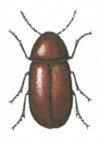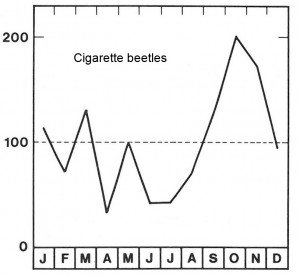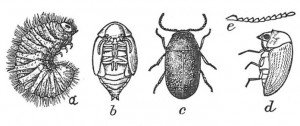

Latin: Lasioderma serricorne.
The cigarette beetle is 2-4 mm long and resembles the drugstore beetle very much. With a little magnification you will notice that the cigarette beetles’ antennae are serrated. Each link is a serration. Drugstore beetle antennae have rounded corners. Cigarette beetles, like drugstore beetles, live in many kinds of products, like rice, cocoa, figs, paprika and various herbal substances and pharmaceuticals. They also have an ability to live with the insecticide, that is nicotine, and this quality has made the cigarette beetle the pest of the tobacco industry.
The larvae can live both in raw tobacco and manufactured goods. Rotten tobacco products should be discarded. Even though the holes can often be covered, very few smokers want the experience of the glow reaching a beetle.
The cigarette beetle lives especially in tropical and subtropical regions. It requires heat. At temperatures below 21 ° C it does not reproduce, and at 18 ° it is paralysed. Optimal temperatures are between 32 and 35 ° C, where the population increases itself 20-fold every month. Cigarette beetles can survive at humidity levels down to 30% RH. Newly hatched larvae are active and can live a week without food. The adult cigarette beetles can fly.

Cigarette beetles in tobacco warehouses are typically exterminated by fumigation. It is also possible to exploit the sensitivity to low temperatures. 15 days at 0 ° C, 7 days at – 4 ° C or just 1 day at – 12 ° C will kill all stages of this species.




